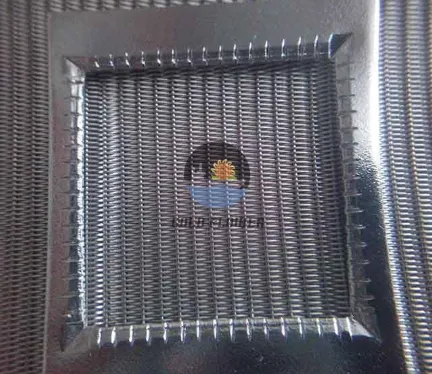Apr. . 18, 2025 09:11 Zurück zur Liste
Dutch Woven Wire Mesh: Diverse Applications and Values
Niederländisches Drahtgeflecht, With its unique weaving process and excellent material properties, it has demonstrated outstanding application value in various fields. This grid structured material is not just a simple industrial product, but a solution that combines exquisite technology and practical functions, widely used in various aspects such as filtration, separation, protection, decoration, etc.

Duty woven wire mesh plays a crucial role in the field of filtration
Its precise mesh structure can effectively block solid particles, thereby achieving purification of liquids or gases. For example, in the petrochemical industry, it is used to filter impurities in crude oil, improve refining efficiency and product quality. In the field of water treatment, it can remove suspended solids from wastewater and ensure the safety of drinking water. In addition, in the food processing and pharmaceutical industries, high-precision woven wire screen cloth is crucial for ensuring product hygiene and quality.
Duty woven wire mesh also performs well in separation technology
Its unique grid structure can effectively separate particles based on their size, and is applied in fields such as powder metallurgy and pigment manufacturing. For example, it can be used to screen metal powders of different particle sizes, thereby controlling the performance and quality of the final product. In addition, in the field of scientific research, woven wire cloth mesh has also been used to separate biomolecules such as cells and proteins of different sizes, providing a powerful tool for biomedical research.
Duty woven wire mesh also plays an important role in the field of protection
Its high strength and corrosion resistance make it an ideal material for protective equipment. For example, it can be used to manufacture safety nets to prevent personnel from falling or objects from falling. In the field of architecture, it can be used to reinforce concrete structures and improve the seismic performance of buildings. In addition, in the field of electromagnetic shielding, specially designed woven wire cloth can effectively shield electromagnetic interference and ensure the normal operation of electronic devices.
It is worth mentioning that woven metal cloth is gradually being applied in the field of decoration. Its unique texture and luster give it a beautiful visual effect, making it an ideal material for building exterior walls, interior decoration, and other fields. For example, it can be used to create art installations and add artistic flair to public spaces.
In summary, due to its unique weaving process and excellent material properties, duty-free woven wire mesh has demonstrated its diverse application value in multiple fields such as filtration, separation, protection, and decoration. With the continuous advancement of technology and the increasing demand, the application prospects of duty-free woven wire mesh will be even broader, making greater contributions to the development of various industries.
Dutch Woven Wire Mesh FAQs
What is duty woven wire mesh?
Duty woven wire mesh is a special type of stainless steel wire mesh that uses a double line weaving process, where the diameter of the warp (longitudinal line) is larger than that of the weft (transverse line). This weaving method makes the mesh conical, which can effectively filter particles, especially suitable for fine filtration.
What are the main characteristics of dutch woven wire mesh?
High filtration accuracy: Due to the conical mesh design, it can intercept smaller particles.
High strength: The thicker warp enhances the mechanical strength of the mesh.
High flow rate: The mesh design allows for low resistance when fluid or gas passes through.
Corrosion resistance: usually made of stainless steel material, suitable for harsh environments.
What are the main application areas of dutch woven wire mesh?
Filtration and Separation: Used in industries such as water treatment, petrochemicals, food and beverage.
Screening: Used for graded screening in the mining and construction industries.
Gas purification: used for air filtration and gas separation.
Electronics industry: used for shielding and protection.
What is the difference between dutch woven wire mesh and regular woven wire mesh?
Weaving method: Duty woven wire mesh adopts double line weaving, with different diameters of warp and weft, while ordinary woven wire mesh usually uses a single wire diameter.
Mesh shape: The mesh of duty-free woven wire mesh is conical, while the mesh of ordinary woven wire mesh is square or rectangular.
Filtering performance: Duty woven wire mesh is more suitable for fine filtering, while ordinary woven wire mesh is suitable for general screening.
How to choose a suitable dutch woven wire mesh?
When making a choice, the following factors should be considered:
Filtering accuracy: Select the appropriate mesh size based on the particle size to be intercepted.
Material: Choose stainless steel or other corrosion-resistant materials according to the usage environment.
Wire diameter and mesh size: Choose the appropriate combination of wire diameter and mesh size based on flow and strength requirements.
Work environment: Consider factors such as temperature, pressure, and chemical corrosion.
Aktie
-
What Are the Key Applications and Benefits of Chicken Wire Gabion and Related Retaining Solutions?
NachrichtJul.18,2025
-
What Are the Key Advantages and Applications of PVC Coated Gabion Wire Mesh and Related Solutions?
NachrichtJul.18,2025
-
Welded Gabion Mesh Solutions: Strength and Versatility in Construction
NachrichtJul.18,2025
-
Essential Solutions for Slope Stability: A Focus on Protective Nets
NachrichtJul.18,2025
-
Durable Solutions for Erosion Control and Construction: Galvanised Gabion Systems
NachrichtJul.18,2025
-
Constructing Functional Structures: The Art of Making Gabions
NachrichtJul.18,2025

